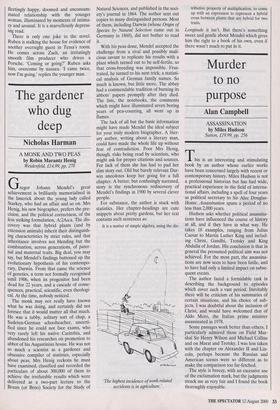The gardener who dug deep
Nicholas Harman
A MONK AND TWO PEAS by Robin Marantz Henig Weidenfeld, £14.99, pp. 278 Gregor Johann Mendel's great achievement is brilliantly memorialised in the limerick about the young lady called Starkey, who had an affair and so on. Mrs Henig, his new biographer, prefers the pre- cision, and the political correctness, of the less striking formulation, A:2Aa:a. The dis- covery was that hybrid plants (and by extension animals) inherit their distinguish- ing characteristics by strict rules, and that inheritance involves not blending but the combination, across generations, of pater- nal and maternal traits. Big deal, you may say, but Mendel's findings buttoned up the evolutionary hypothesis of his contempo- rary, Darwin. From that came the science of genetics, a term not formally recognised until 1906, when its progenitor had been dead for 22 years, and a cascade of conse- quences, practical, scientific, even theologi- cal. At the time, nobody noticed.
The monk may not really have known what he was doing, and certainly did not foresee that it would matter all that much. He was a tubby, solitary sort of chap, a Sudeten-German schoolteacher, uncerti- fied since he could not face exams, who very rarely left his native Carinthia, and abandoned his researches on promotion to abbot of his Augustinian house. He was not so much a scientist as a gardener and obsessive compiler of statistics, especially about peas; Mrs Henig reckons he must have examined, classified and recorded the particulars of about 300,000 of them to achieve the irrefutable results which were delivered as a two-part lecture to the Brunn (or Brno) Society for the Study of Natural Sciences, and published in the soci- ety's journal in 1864. The author sent out copies to many distinguished persons. Most of them, including Darwin (whose Origin of Species by Natural Selection came out in Germany in 1860), did not bother to read it.
With his peas done, Mendel accepted the challenge from a rival and possibly mali- cious savant to replicate his results with a plant which turned out to be self-fertile, so that cross-breeding was impossible. Frus- trated, he turned to his next trick, a statisti- cal analysis of German family names. So much is known, but little more. The abbey had a commendable tradition of burning its abbots' papers promptly after they died. The lists, the notebooks, the comments which might have illuminated seven boring years of pea-counting, all went up in flames.
The lack of all but the basic information might have made Mendel the ideal subject for your truly modern biographer. A liter- ary author, writing about a literary man, could have made the whole life up without fear of contradiction. Poor Mrs Henig, though, risks being read by scientists, who might ask for proper citations and sources. For lack of them she has had to pad her slim story out. Old but barely relevant Dar- win anecdotes keep her going for a full chapter. A better, but confusingly narrated, story is the synchronous rediscovery of Mendel's findings in 1900 by several clever people.
For substance, the author is stuck with statistics. Her chapter-headings are cute snippets about pretty gardens, but her text contains such sentences as: It is a matter of simple algebra, using the dis- The highest incidence of work-related accidents is in agriculture.'
tributive property of multiplication, to come up with an expression to represent a hybrid cross between plants that are hybrid for two traits.
Longitude it isn't. But there's something sweet and gentle about Mendel which gives him the right to a book of his own, even if there wasn't much to put in it.


























































 Previous page
Previous page